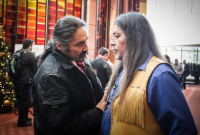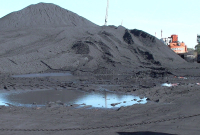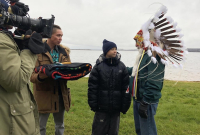Support strong Canadian climate journalism for 2025
It’s been more than a dozen years since the metaphorical alarm was first sounded, and yet the residents of Fort Chipewyan still don’t know what’s killing them.
What they do know is that there are still elevated rates of cancer in the northern Alberta community. They also know that nothing's been done to address the issue, despite community leaders asking for further investigation for years.
“It’s like a silent killer. You don’t know what it is that’s out there, what’s causing you to get sick,” said Chief Allan Adam, leader of Athabasca Chipewyan First Nation since 2007. Adam was in Ottawa last week campaigning, once again, to get answers for his community.
Athabasca Chipewyan First Nation, Mikisew Cree First Nation and the hamlet of Fort Chipewyan are all situated near the mouth of the Athabasca River, where it flows into Lake Athabasca, in the province’s upper northeast, after traversing more than 1,200 kilometres from its source in the Columbia Icefields.
On its route, the river flows through Canada’s oil patch, giving rise to the theory that the oil-and-gas industry is responsible for the illnesses, having poisoned people for years by contaminating the environment. Government bodies and researchers have challenged that theory, leading to a call for a new more conclusive health study that could provide real answers.
Thirteen years ago, Warren Simpson, a member of Athabasca Chipewyan First Nation, told CBC News how afraid he was that he’d die of cancer from living in that community. He said he’d been lucky enough to fight off cancer the first time he was diagnosed, but he worried that he wouldn’t be so lucky if there was a second bout.
"My dad, my sister, my aunt, a lot of my cousins have it, my friends' families ... A lot of them have died of cancer, and some of them are dying now of cancer," he said in 2006.
Last month, he posted his first entry on his blog, outlining how he was losing his battle with a rare form of bile-duct cancer called cholangiocarcinoma, which is only supposed to affect one in 100,000 people, according to American statistics.
He wanted to write the blog “mostly to give awareness of so many damn cancers that we suffer in Fort Chipewyan,” he wrote on Facebook. “Love you all for your support, and let’s pray for all the people with cancer.”
Simpson died days later.
Chief Adam says he wishes Simpson were an exception, but 10 other people have passed away in the last few months, and seven of them were from various forms of cancer.
Simpson only spoke to reporters about cancer in his community because a Fort McMurray family doctor started sounding the alarm in 2006. Dr. John O’Connor was worried about the number of cancer cases he was seeing in Fort Chipewyan — especially cases of bile duct cancer, or cholangiocarcinoma — as he treated patients there remotely.
After O’Connor raised concerns, the Alberta Cancer Board — supported by the province’s governing health authority, Alberta Health Services — conducted a comparative survey to see whether he was right.
Public attention waned as the cancer board did its research. When the findings were released in 2009, they showed cancer rates were indeed higher in Fort Chipewyan than what would be expected. In a community of roughly 1,200 people, the study found, you would expect to see 39 cases of cancer. Instead, it found 51 cases, a difference of 30.7 per cent.
Rates were particularly high in cancers of the blood and lymphatic system, biliary tract and soft tissue.
“These increases were based on a small number of cases and could be due to chance or increased detection. The possibility that the increased rate is due to increased risk in the community, however, cannot be ruled out,” the report reads.
While this study confirmed there was a problem, a full investigation by Health Canada would be needed to sort out what was causing it. This comprehensive baseline health study was recommended by the Alberta Cancer Board back in 2009 but it has never been completed.
That’s why Chief Allan Adam was back in Ottawa last week, pounding the pavement, speaking with different government agencies and departments, trying to force the Liberal federal government to make good on that promise made a decade ago.
“The only reason they don’t want to do it is because of the magnitude — how big this is going to be,” Adam said.

Health Canada directed all questions to Indigneous Services Canada, which provided a statement to National Observer saying, “Since 2009 many efforts have been undertaken to bring partners together to create a framework for the Fort Chipewyan Regional Baseline Health Study, but consensus has yet to be reached.”
The Indigenous Services Canada spokesperson directed all questions related to the delay to the leadership of the First Nations.
“Both federal and provincial partners have made commitments to fund this work since 2009. Indigenous Services Canada, Alberta Health and the communities continue to work together to move forward to develop a framework,” the spokesperson said by email.
Ultimately, Adam said, the delay over the baseline study has come down to disagreement over who would have control over the research and whether industry could be part of the process.
“We don’t want industry involved,” Adam said flat out.
Furthermore, failures to consult with the communities have fishtailed previous efforts to conduct such studies, leading the communities to mistrust the intentions of government.
Public attention flared up again when influential environmental scientist David Schindler dug into the water quality of the Athabasca River.
His study, published in 2010 by the Proceedings of the National Academy of Sciences journal, confirmed that oilsands developments had contributed heavy metals, such as mercury, arsenic, lead and cadmium, and other contaminants — toxic even in low amounts — to the region’s waterways.
It seemed like the region’s residents had two pieces of the puzzle: a study proving they were indeed getting sick and a study showing toxic contaminants in their water supply.
Many refuted and cast doubt on Schindler’s findings, including a set of studies published seven years later by William Shotyk, a professor of agriculture and environment at the University of Alberta. Shotyk looked at silver, cadmium, lead, antimony, thallium, arsenic and lead, and found that the presence of these elements in the waterways was no different upstream from oilsands projects when compared with downstream testing.
Two research studies. Two very different conclusions about contamination. Both sets of research have seen plenty of criticism — criticism that is generally and predictably divided between those who oppose oil-and-gas development and those who support it.
The sources of research funding can be divided along similar lines. Schindler’s research was funded in part by the Tides Foundation (donations from this American charity are at the centre of conservative claims of a foreign-funding conspiracy).
Shotyk's research was paid for by the Canada's Oil Sands Innovation Alliance and Alberta Innovates, both organizations whose express interest is innovating the oilsands.
After Schindler had published his study, without any movement on the baseline health study, the two First Nation communities of Athabasca Chipewyan First Nation and Mikisew Cree First Nation took matters into their own hands. They pooled their resources to begin funding research that the communities could be confident in. With some additional funding from Health Canada, a three-year, $1-million study got off the ground.
The research project was led by Stephane McLachlan, a professor at the University of Manitoba. He remembers being approached by community leaders specifically because he came from outside the province, which he believes helped build some trust automatically.
“[The study] was this attempt to bridge the science and the Indigenous knowledge that came from doing interviews and focus group discussions and talking with people and getting to know people over the years,” McLachlan said.
Based on the grassroots interviews, McLachlan quickly realized the fear of not knowing what was making people sick was influencing how people lived, right down to fear of their traditional foods.
“A lot of those kinds of drivers were preventing people from going out on the land, making people question the safety of the traditional foods. And so that had implications, obviously, for how people engage with the environment,” McLachlan said.
In 2014, while McLachlan’s study was underway, Dr. O’Connor travelled to Washington to testify before the U.S. Senate in hearings on the Keystone XL pipeline. In his testimony, O’Connor stated that he believed elevated cancer rates in Fort Chipewyan were linked to chemicals leaching into the Athabasca River from the oilsands.
The Alberta government rejected that claim, stating there was "insufficient evidence to link the incidence of cancer in Fort Chipewyan to oil sands operations" and arguing that rates of cancer are "within the expected range."
Health Canada threatened to suspend O’Connor’s medical licence for raising undue alarm.

Then, later that year, McLachlan released the findings of his study.
The research measured contaminants not only in water but also in beavers, ducks, fish, moose and muskrats — animals consumed as part of a traditional diet for those who continue to live off the land in the Peace-Athabasca Delta. He concluded that the animals contained high concentrations of pollutants such as carcinogenic polycyclic aromatic hydrocarbons and heavy metals such as arsenic, mercury, cadmium and selenium.
All of these are byproducts of extracting and upgrading bitumen. Arsenic in particular has been linked to increased risk of biliary tract cancer.
Despite these findings, McLachlan watched in horror as governments waited out the news cycle and again conducted no further investigation.
“It’s just too easy for a government and industry because I think it was quite deliberate on their part,” McLachlan said. “They could have engaged with the research. They could have engaged with the leadership. But they knew that that would just create unwanted attention. And so what they did is — they knew that whatever that media cycle is, one or two weeks, whatever it is — they just hid in the weeds and waited for it to blow over so they could just continue with business as usual.”
McLachlan says he hopes that in years to come, no matter how long it takes, the Canadian government is held accountable for its inaction.
Also in 2014, Alberta Health Services conducted a follow-up cancer survey to the one done in 2009. It concluded that the overall cancer rates were no longer especially high, but the region was seeing continued elevated rates of biliary tract and newly elevated rates of cervical cancer. The latest update to the survey is expected to be released early in 2020, according to AHS.
One last blast from O’Connor raised the issue in the media again, in 2015, when, despite remaining in good standing with the medical community, O’Connor was fired from the position he held with the local health authority, which employed him to care for the people of Fort Chipewyan.
O’Connor no longer works in the northern community but continues to keep tabs on what goes on there. With all the attention over the years, O’Connor said he can’t fathom how nothing has been done to try to ameliorate the situation in Fort Chipewyan.
“I’m extremely frustrated. I’m beyond anger. I was hopeful when the NDP got into power, but that hope was dashed. The economy and other issues took precedence,” O’Connor said.
The NDP, now the official opposition in Alberta, did not respond to a request for comment.
Since 2015 when O’Connor was fired, there’s been radio silence on the illnesses in Fort Chipewyan and surrounding communities. There is still no baseline health study to answer people’s questions about what is going on.
However, over the course of this battle for Health Canada to conduct a baseline health study, the Oil Sands Monitoring Program was established to keep tabs on any possible contamination from the industrial area. The program is a joint effort between the federal and provincial governments. Its most recent study, released in 2018, found increased presence of aluminum, copper, iron and lead in the Athabasca River, surpassing water safety guidelines. It also found an increased presence of arsenic in the Athabasca’s tributaries.
The report said these increases were not directly linked with upstream oilsands projects, but that in the Muskeg River, one of the tributary sources, that land-clearing associated with oilsands mining was believed to have played a role in increasing contamination.
National Observer asked to speak with the co-lead of the Oil Sands Monitoring Program, scientist Monique Dube, who works in Alberta Environment and Parks, but the interview was declined by the departmental communications team, citing scheduling conflicts.
When reached for comment, AHS did not offer any suggestion that anything else was being done on their part to calm community concerns or address the issue. A request for an interview was made, but they made no one available.
“At a minimum, this comprehensive health study that we've been calling for and demanding, over the last 15 or 20 years, needs to be done,” McLachlan said. “It needs to be done in a way where [the First Nations are] full partners in that work. That they have ultimate say in terms of the nature of the work, and the focus of the work, and ultimately how the outcomes are shared.”
The stress and the pain of having all of this go on for years has meant that Chief Adam is frustrated beyond belief. Talking about it isn’t easy.
“Until we do a community baseline study, all of these will just be questions,” Adam said. “It gets frustrating as a First Nations leader. You know, you’re always out there advocating and people are always looking at you saying, ‘Here comes trouble, again.’ Well that’s not the point, right? We’re trying to work together here and it’s not our lifestyle that’s causing all of these health problems.”








Comments
"Two research studies. Two very different conclusions about contamination."
Unfortunate piece of reporting.
The Observer simplistically reduces the issue to a "He said, she said" contest, ignoring the weight of the evidence.
No mention is made of subsequent studies by Environment Canada, which confirmed Schindler's results — not Shotyk's.
If industrial contaminants are going up the smokestacks, and found in the snow; and if mining exposes bitumen deposits to the elements; and if unlined tailings ponds are leaking, common sense eliminates all doubt that industrial releases are contaminating the ecosystem beyond background levels. Unless, of course, pollutants magically disappear.
When the river is tested (e.g., during spring run-off), and whether river sediments are included, affects the results.
Industrial activity raises contaminants beyond low background levels. Contaminants are identified, measured, and tested singly. The synergistic AND chronic effects of this toxic cocktail on organisms are untested and unknown. But surely lesions and tumours in fish, and rare cancers in a small community must have a cause.
Schindler has won several academic honors and prizes for his work. Shotyk has made a career of attacking, downplaying, and misrepresenting research that sounds the alarm about industrial pollution (e.g., AB coal-plants).
As one study after another attests, the industry grossly under-reports its emissions (of all types).
"criticism that is generally divided between those who oppose oil-and-gas development and those who support it"
Something of a slander against Schindler’s integrity. I.e., Schindler found the results he was looking for. As opposed to approaching the problem objectively and observing rigorous scientific procedure.
If Schindler opposes oilsands development, more likely it's because of his findings, not the other way around.
"Schindler’s research was funded in part by the Tides Foundation"
The implication being that Schindler’s results were somehow tainted by the source of his funding. Lost is the fact that Schindler first requested funding from the oil industry and was turned down. Again, subsequent studies by Environment Canada confirmed Schindler's results.
As an appropriate remedy, perhaps The Observer could call on Drs. Schindler and Timoney to respond to Shotyk's contradictory findings. How about a response from other independent scientists?
It would be helpful to distinguish between Tides Canada and the separate US Tides organization, and also to clarify that Tides Canada is a Donor Advised Funder. In other words, it is a charity because it does the good work of administering funds allocated by donors. It doesn't make charity "donations" from funds of its own.
Hi Geoffrey,
Just reposting my response that I added on Facebook for other readers to see.
I wanted to explain why I reported on the two water experiments the way I did, because I appreciate your comments.
I wasn't trying to say anyone *should* discount either study, or even that the two are equal. What I was trying to do was demonstrate how politics has crossed into science. And how for many people, especially here in Alberta, hearing that Schindler accepted funds from Tides automatically discounts his research -- like it or not. Likewise, people like yourself are discounting Shotyk's findings for various reasons. Again, I'm not telling people they *should* feel that way... in my reporting I try to never tell people how they *should* feel, I rather point out what is happening. And what has happened here is that people on both sides of this debate -- largely divided between pro and anti-O&G development camps -- have decided to discount one or both of these reports. (I did point out that the problem with Tides funding originates from a debunked conspiracy theory.)
So given that people are in the habit of discounting one or both of these reports, I then point to the community-driven study that is the only research that's gone forward with Health Canada funding. I do also point to the work done by Environment Canada through the Oil Sands Monitoring Program.
I could have written an entire article about those two water studies... and in fact many have. But that wasn't what I was trying to unpack in this article.
"The NDP, now the official opposition in AB, did not respond to a request for comment."
Notley's NDP should be excoriated for its failure on this file.
In opposition, the NDP voiced support for a comprehensive healthy study on cancers in Fort Chipewyan. In govt, the only sound was crickets.
"[Allan Adam, chief of the Athabasca Chipewyan First Nation,] said his people continue to die from cancer at alarmingly high rates, a fact he blamed on oilsands developments. 'Whatever food I'm bringing in from the bush, it is getting our people sick.'
"The chief said he had hoped that after four decades of Conservative rule in Alberta, things would be different when the NDP government came to power in May 2015. But under the Rachel Notley government, he said, it's business as usual. 'I feel very, very ashamed to call myself an Albertan. I feel very, very ashamed to call myself a Canadian citizen.'" (January 2017)
• www.cbc.ca/news/canada/edmonton/jane-fonda-oilsands-indigenous-justin-t…]
"'Nothing came about:' Alberta First Nation revives oilsands pipeline lawsuit"
Chief Allan Adam: "The talk around our table is that the NDP government is just another platform of the previous Conservative government with a different logo. Nothing has changed."
• https://www.nationalobserver.com/2016/09/19/news/nothing-came-about-alb…
Chief Allan Adam: "We can hardly get a boat through the Delta, migratory birds don’t fly over, the fish are diseased, and our people are sick. Throughout this whole time Syncrude has not provided any compensation to ACFN for these impacts. Now, Syncrude wants to make their mines even bigger.”
"Athabasca Chipewyan First Nation seeks to stop Syncrude oilsands expansion project" (National Observer)
• https://www.nationalobserver.com/2018/12/17/news/athabasca-chipewyan-fi…
Dr John O'Connor: "Pre-election, the NDP/Rachel Notley were vocally supportive of bringing accountability and responsibility to bear on the environmental and health impacts,especially downstream, of the tarsands. After the AB Cancer Board report on Fort Chipewyan, she was notably outspoken on the need to comply with the recommendation for a comprehensive health study of Fort Chip, which was never even started.
"Now—it’s buried and forgotten. Such hypocrisy."
"Oilpatch odours in northwestern Alberta still pungent, years after inquiry"
"[Donna Daum, a retired teacher] points out that members of the current NDP govt — including Premier Rachel Notley — were loud in their support when they were in opposition.
"'(Notley) talked about the precautionary principle, which obviously is no longer in their dictionary. I can't believe how these dictionaries get rewritten the moment there's some responsibility attached to things.'"
• http://www.cbc.ca/news/canada/edmonton/oilpatch-odours-in-northwestern-…
Melina Laboucan Massimo, Lubicon Cree Nation:
“We can’t drink the water from the streams where the hunters go. We can’t pick medicines and berries — all of the things our people have done for thousands of years, since time immemorial...cultural genocide is what we’re seeing at this point, and it’s not okay.”
"Chief Bob Chamberlin says Trudeau’s Kinder Morgan deal was ‘shameful’" (National Observer, May 30 2018)
• www.nationalobserver.com/2018/05/30/news/chief-bob-chamberlin-says-trud…
"Currently, elders like Bernadette L'Acorde say they can't hunt and fish in the vicinity of Fort MacKay because of concerns about contamination from the neighbouring oilsands sites.
"'We used to hunt and fish. But not anymore. [The land] is all poisoned.'"
"Métis community in oilsands buys 'pristine' land to hunt and trap" (CBC, Nov 28, 2018)
• www.cbc.ca/news/canada/edmonton/metis-oilsands-hunt-trap-mckay-metis-1…
"Where oil and water mix" (Globe and Mail, Nov 6, 2015)
"'...the people of Fort McKay face an issue central to that struggle: Resource development offers an economic lifeline – but does it outweigh the detriment to both the landscape and the people's well-being?
'With the industry being here, you can really take advantage of it and get good jobs and make good money,' Ms. Mercer explains, but adds, 'people are pretty sick – more sick than they ever were before.'
'...But the health impact is the chief concern of people in Fort McKay. They complain of rashes and asthma; they report elevated rates of rare cancers and worry about an apparent increase in the number of premature births. The pristine wilderness is such a distant memory that they now must drink bottled water, no longer eat fish from the Athabasca River and have been warned to take short, lukewarm showers to avoid skin problems.
The elders also fear the oil industry's relentless march is destroying the plants and animals that have sustained the Cree and Dene since time immemorial.
Ms. Mercer says she is 'very worried' that 'by the time it's the younger generation's time to hunt and fish and gather for their families, everything will be gone.'
'...Fort McKay residents complain of foul odours and poor water quality, as well as the increased incidence of asthma, rare cancers and premature births. Researchers have found industrial toxins in the area's fish and berries as well as on the bottom of its lakes and in the winter snow pack.
'...We're not rich by any means in Fort McKay. Our kids are in poor health … We'll wake up one day, and it will be too late.'
'Back in Fort McKay, however, people worry about what industrialization is already doing to their health.
'...Celina Harpe, an elder in the community, says the smell 'makes me sick,' and regularly drives her indoors with a headache and sore throat.'
'We do see the changes in the traditional food,' Ms. Lepine says. 'The elders say the animals are sick – and they fear that is causing the cancer and other health problems.'"
• https://www.theglobeandmail.com/news/alberta/where-oil-and-water-mix-oi…
And considering the delay and the obvious need for action, how likely are we to ever see any kind of study on the effects of the fracking that is going on all over Alberta, in our most productive agricultural areas? Now banned in the UK, the dangers of this activity are obvious and well recognized internationally; how will we save our potential for a healthy environment "after oil and gas"?
I worked at the oil sands in the late 1970’s. Just at the beginning of the great expansion. Many of the workers, that were there at the time, and from other Provinces outside Alberta, expressed concern over the pollutants going into the river and the affect on residents of “Fort Chip”. Almost 50 years later, the same concerns are raised and falling on deaf ears!
OK, so there is recognition that there is a higher than normal incidence of cancer in the communities that just Happen to be downstream from the oil sands works. There is differing opinion as to what is the cause. So, why are WE the Government not investigating this problem by focusing on the afflicted without concern for the upstream activities. Can we not research and attempt to find a cure and not turn this into a blame debate?
thank you Geoffry Pounder for your detailed critique. This is a national crime abetted by fossil captured "law" and petro governance. But also like what happened with Grassy Narrows Sydney coal mines. Asbestos, etc. Tell me what I can do to force real action to stop the poisoning and environmental devastation of ALL life forms in our own Mordor/Alta.
A friend of mine lived in Fort McMurray for some years, and at one period her husband was driving a truck delivering equipment to some of the companies there and the like. During that time a worker got one drop of water from one of those tailings ponds splashed on his lip and had to spend a week in the hospital with toxic shock. And those ponds cover many acres, held in only by earthen dikes. Sooner or later some of those dikes will collapse and that water will flow down a river poisoning a huge area. It should be no surprise to anyone that people downstream are getting health problems by a little leakage.
Some enterprising environmentalist should bottle the water downstream from the Tar Sands and give a years supply to the Environment Minister and Premier to drink.